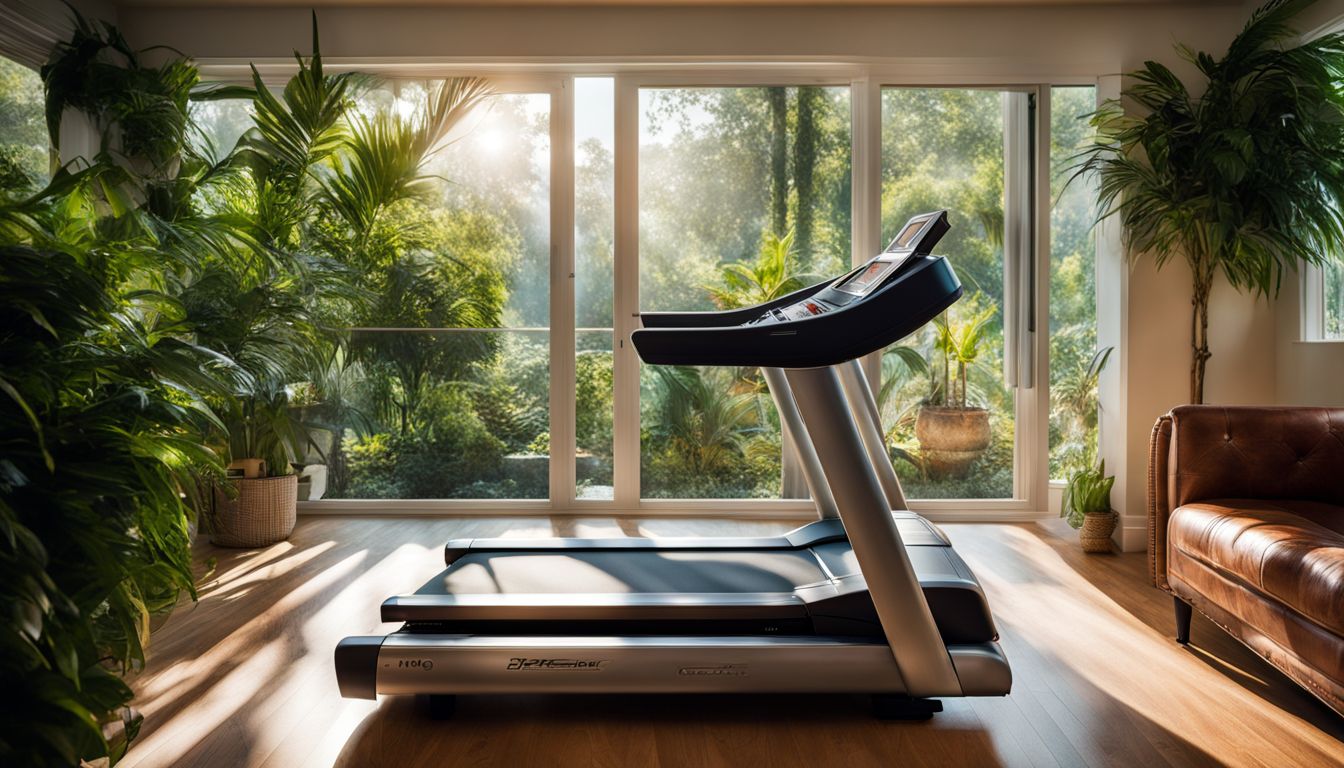Stepping onto a treadmill can feel daunting if you’re unsure where to start with your fitness journey. Treadmills offer the convenience of a personalized workout at the touch of a button, perfect for beginners.
This guide unpacks effective treadmill workouts that cater to newbies—equipping you with the tools for safe, enjoyable, and productive exercise sessions. Ready for a healthier you? Keep reading!
Key Takeaways
- Treadmills are beginner – friendly because you can control the speed and incline to match your fitness level.
- Walking on a treadmill for 30 minutes, five times a week, meets the CDC’s exercise recommendations.
- A no – incline walking workout is good for starters, while adding an incline builds leg strength and endurance.
- Interval workouts on treadmills help improve running speed and burn more calories in less time.
- Regular treadmill workouts combined with healthy eating can be part of an effective weight loss plan.
Understanding Treadmill Workouts for Beginners
Starting a treadmill workout can be a smooth way to get into running or walking for fitness. Beginners often find treadmills friendly because they allow control over speed and incline.
You might not know this, but it’s easier to maintain a consistent pace on a treadmill than outside. This helps you build stamina and prevents injuries like shin splints.
It’s key to begin slowly with simple goals in mind. Know that experts suggest brisk walking for 30 minutes, five days per week, meets exercise targets set by authorities such as the CDC.
Treadmill workouts are great because they can happen no matter the weather and offer privacy if you’re self-conscious exercising in public spaces.
Next up: Discover how treadmill sessions benefit your health and fitness journey!
Benefits of Treadmill Workouts

Treadmill workouts for beginners are more than just running in place. They give you the power to control your exercise. With a treadmill, you can set the exact speed and incline that work best for you.
This means progress at your own pace is easier and safer.
Running on a treadmill helps keep your body in the right position while maintaining a steady pace. You won’t have to worry about uneven ground or bad weather slowing you down. Treadmills also have features that let you change your workout as you get stronger and faster.
Whether it’s incline walking or high-intensity interval training, treadmills offer all kinds of exercises.
For recovery after injury, treadmills are very useful too. They let you manage each part of your run without stress on hurt muscles or joints. Plus, they’re perfect for any weather – rain or shine, hot or cold – so nothing gets in the way of meeting those fitness goals!
How to Use a Treadmill
Mastering the controls of a treadmill sets you on the path to an effective workout; familiarize yourself with pace adjustments and safety features to stride confidently towards your fitness goals—keep reading for detailed insights into optimizing your treadmill experience.
Basic treadmill settings for beginners
Treadmills are great because they let you choose the speed and incline. You’ll get used to treadmill walking in about eight minutes. Here’s how to get started with basic settings:
- Find the power button – It’s usually big and red. Press it to turn on your treadmill.
- Look at the safety key slot – Attach the clip to your clothes. If you slip, it stops the treadmill.
- Start with a slow speed – Begin walking at 1 or 2 mph to warm up your muscles.
- Increase speed gradually – After warming up, boost your pace until you’re comfortable but not out of breath.
- Use the incline button – Play with small inclines like 1% or 2% to make your walk a bit harder.
- Try using programs – Most treadmills have pre – set workouts for beginners; give them a try.
- Keep an eye on your heart rate – Use the treadmill’s sensors to check if you’re working hard enough but still safe.
- Always press ‘cool down’ – After exercising, use this function so your body can slowly relax.
Ideal Treadmill Speed and Incline for Beginners
Beginners should start slow on the treadmill. A good speed is between 2 and 4 mph, which lets you walk comfortably. As you get used to walking, gradually increase the speed. Aim for a pace that gets your heart rate up but still allows you to talk.
Using incline adds challenge to your workout. Start with a 1% incline, which mimics outdoor walking conditions. You can bump it up as you feel stronger—just take it one step at a time to avoid strain or injury.
Remember that safety comes first!
Treadmill Workout Plans for Beginners
Whether you’re stepping onto the treadmill for the first time or looking to refresh your routine, our guide offers a diverse array of beginner-friendly workouts—tailored to elevate your fitness journey with confidence and variety.
Continue reading, as these expertly crafted plans are just a scroll away—ready to kick-start your path to health and vitality.
No-Incline Walking Workout
A no-incline walking workout is perfect for beginners on the treadmill. It’s simple and easy to follow, helping you meet physical activity goals.
- Start by stepping onto the treadmill and attaching the safety clip to your clothes.
- Stand tall, look forward, and hold on to the handrails for balance.
- Set the treadmill’s speed to a comfortable walk, around 2 to 3 mph.
- Walk at this pace for five minutes to warm up your muscles.
- After warming up, increase your speed slightly but stay at a brisk walk.
- Aim to walk like this for 20 minutes. You should feel your heart rate going up but still be able to talk.
- If you feel good, push yourself a little faster every few minutes.
- Make sure you’re drinking water before, during, and after your workout. This helps prevent symptoms of dehydration.
- Cool down by reducing your speed back to 2 mph for the last five minutes.
- Finish by stretching your legs and taking deep breaths to relax.
Incline Walking
Incline walking on a treadmill strengthens your leg muscles and builds endurance. It’s great for beginners who want to step up their workout game without running.
- Start at a zero incline to warm up your body for five minutes.
- Increase the incline gradually, beginning with a 1% grade.
- Walk at this incline for two minutes to get used to the angle.
- Boost the incline every few minutes until you reach a level that feels challenging but sustainable.
- Maintain your speed; don’t go too fast. Your focus is on the uphill climb.
- Aim for an incline between 4% and 6% as you progress, depending on comfort and difficulty.
- Keep your hands off the handrails; let your legs do the work.
- Walk on the incline for at least 20 minutes to build strength in your legs and core.
- Listen to your body; if the workout feels too intense, lower the incline slightly.
- Cool down by reducing the incline back to zero over a five – minute period.
12-3-30 Workout
After exploring the benefits of incline walking, let’s dive into the 12-3-30 workout. This routine boosts your fitness journey with a simple yet effective approach.
- Set the treadmill incline to 12%. This slope mimics a steep hill and increases the challenge.
- Adjust your speed to 3 miles per hour. It’s not too fast, but enough to raise your heartbeat.
- Walk for 30 minutes at this setting. Keep moving and stay consistent through half an hour.
- Focus on maintaining good posture. Stand tall and avoid leaning on the handrails.
- Breathe deeply and evenly as you walk. This helps control your heart rate.
- Start with a five-minute warm-up at a lower incline. Gradually prepare your body for the steeper angle.
- Finish with a cool down. Slowly reduce the speed and incline over five minutes after completing the main workout.
- Do this workout three times a week to start seeing improvements.
Recovery/Easy Run
Recovery runs help your body heal after hard workouts. They build endurance without stressing your muscles too much.
- Start with a slow jog on the treadmill to warm up. Keep the pace comfortable.
- Run at a consistent, easy speed. Aim for a pace that allows you to talk without huffing and puffing.
- Set the treadmill incline to 1% to mimic outdoor running conditions.
- Keep this workout between 20 to 30 minutes long. It’s not about speed but about moving and recovery.
- Listen to your body throughout the run. If you feel pain or discomfort, slow down or stop.
- Focus on deep breathing. This helps get more oxygen to your muscles and improves recovery.
- Finish with a cool – down walk for 5 minutes. Lower the pace gradually until you come to a complete stop.
- Stretch after getting off the treadmill. Target key muscle groups like calves, thighs, and hips.
Treadmill Interval Workout
After easing into treadmill workouts with recovery runs, it’s time to step up the pace. Treadmill interval workouts are great for building endurance and burning calories. Here’s how to get started:
- Kick off with a 5 – minute walk at around three mph to warm up your muscles.
- After warming up, boost the speed to a comfortable jog for one minute.
- Slow down to a walking pace for two minutes; this is your rest interval.
- Repeat the jog and walk cycle 5 to 10 times, depending on your comfort level.
- Try increasing the jogging speed slightly with each interval if you feel strong.
- Always keep a straight posture and look forward, not down at your feet.
- Use handrails only briefly if needed for balance; avoid leaning on them.
- Finish with a slow 5 – minute walk to cool down and bring your heart rate down gently.
Hill Workout
Hill workouts on a treadmill build strength and power. They’re also great for race training. Here’s how to do a hill workout:
- Start with a 5-minute warm-up at an easy pace.
- Increase the incline to a level that feels like a small hill. You should feel it, but you can still talk.
- Walk or run at this incline for 2 minutes.
- Bring the incline down to zero for 2 minutes. This is your rest period.
- Raise the incline again, making it slightly steeper than before.
- Keep the same speed, and stay at this new level for another 2 minutes.
- Lower the incline and rest for 2 minutes again.
- Repeat these steps, adding more incline each time, up to five rounds.
- For your last round, make the hill your steepest yet. Push hard but stay safe.
- Cool down with a 5 – minute walk at zero incline.
30 Minute Beginner Treadmill Workout
Starting a treadmill workout can be easy and fun. Here’s a simple 30-minute plan for beginners to get moving.
- Warm up by walking at a slow pace for 5 minutes. This prepares your body for exercise.
- Increase your speed slightly and walk briskly for the next 5 minutes. You should feel your heart rate going up.
- For the next 3 minutes, boost the speed so you jog lightly. You’re warming up more now.
- Walk again at a brisk pace for another 5 minutes. Catch your breath and keep moving.
- Raise the incline to a comfortable level and walk for 2 minutes. Your leg muscles will work harder.
- Bring the incline back down and jog for another 3 minutes. Feel free to adjust the speed if needed.
- Go back to a brisk walk on flat ground, doing this for another 4 minutes as you cool down a bit.
- For the last three minutes, slow your pace right down to a gentle stroll. This is your cool – down period.
High-Intensity Interval Training (HIIT) Treadmill Workout for Beginners
HIIT treadmill workouts get your heart pumping and burn calories fast. They’re great for beginners who have little time but want big results.
- Start with a brisk five – minute walk to warm up; aim for three mph.
- Ramp up the speed to a jog that feels challenging yet doable for one minute.
- Slow down to a comfortable walk for two minutes, catching your breath.
- Repeat these speed bursts and recovery walks for 15 minutes.
- Increase the incline by 1% each time you start a jog if you’re ready for more challenge.
- Keep alternating between high-intensity jogs and low-intensity walks; try doing this eight times.
- For the last interval, push yourself a bit harder, running faster than the previous sprints.
- Finish with a five – minute cooldown walk at an easy pace to help your muscles recover.
Essential Treadmill FAQs for Beginners
After exploring high-intensity interval workouts, you might have questions about starting your treadmill routine. Let’s tackle the essentials so you can step onto the treadmill with confidence.
How do you even begin? Start by walking for a few minutes to warm up. Gradually increase your speed and incline over time. What’s a good pace? Aim for one that gets your heart rate up yet allows you to speak without gasping.
What if my feet or shins hurt? That could be a sign of doing too much too soon. Slow down and give your body time to adapt, especially if you’re new to exercise or coming back from an injury like achilles tendinopathy—always follow doctor’s advice here! Can using a treadmill help lose weight? Yes, paired with healthy eating habits, it can be part of a successful weight loss strategy—as recommended by experts, strive for 150 minutes of moderate exercise per week.
Remember these tips as they’re here to guide—not intimidate—you on this journey towards better health and fitness. Keep track of how long and how fast you walk or run—it helps measure progress over time; plus seeing improvements is super motivating! And lastly, mix in some strength training sessions each week: they’ll build muscle and support your new cardio habit.
Incorporating Treadmill Workouts into a Weight Loss Strategy
Treadmill workouts are key for losing weight. You can change the speed and incline to burn more calories. Start slow with walking, then pick up the pace. As you get stronger, add inclines to work your muscles harder.
Mixing different treadmill exercises helps you lose weight faster. Try walking briskly five days a week as recommended by health experts. Change it up with interval training or hill runs on other days.
This keeps your body guessing and burning fat effectively.
Always track your progress and push yourself a little more each time. With regular workouts and smart use of treadmill features like speed control, weight loss becomes an achievable goal!
Conclusion
Begin your treadmill journey with confidence, armed with this guide. You now know the basics and the best ways to start moving. Remember, every step counts towards a stronger you — adjust speed and incline as needed.
Stay consistent and watch your progress unfold. Keep challenging yourself; the path ahead is bright!
FAQs
1. Why should beginners use incline control on a treadmill?
Using incline control adds strength and conditioning to your legs, making workouts tougher and more effective without running faster.
2. How long should a beginner workout on the treadmill to see results?
Consistency matters! Work out for at least 30 minutes, three times a week, and you’ll start seeing changes within a few weeks.
3. Can using a treadmill cause stress fractures?
Treadmills are softer than pavement, reducing impact. But start slow! Too much too soon increases chances of stress fractures.
4. What if I have a health condition; can I still use treadmills safely?
Absolutely – but get a diagnosis or doctor’s advice first to ensure your workout plan is safe for your specific needs.




Leave a Reply